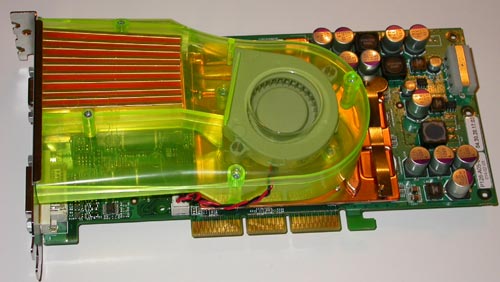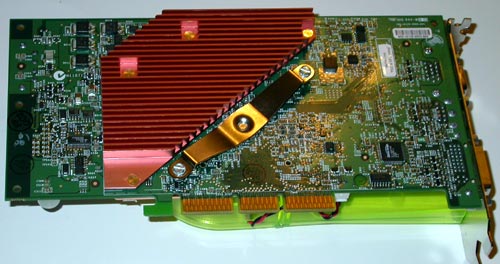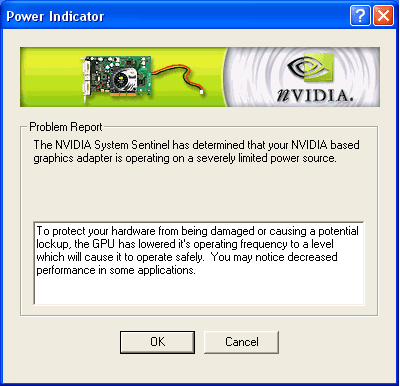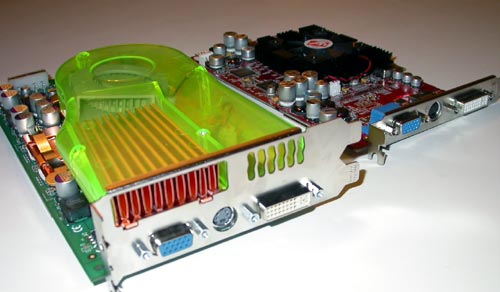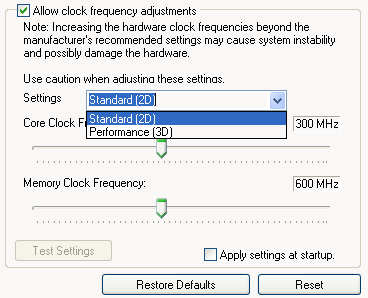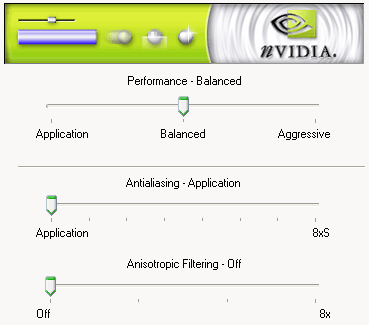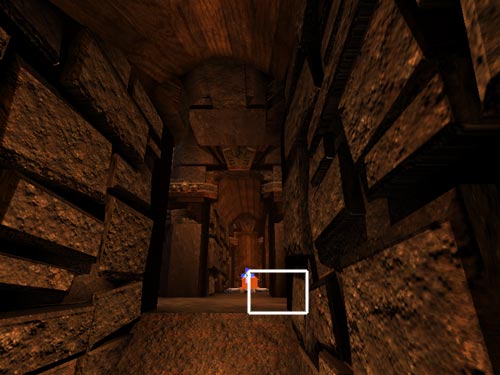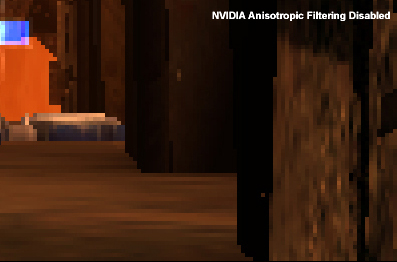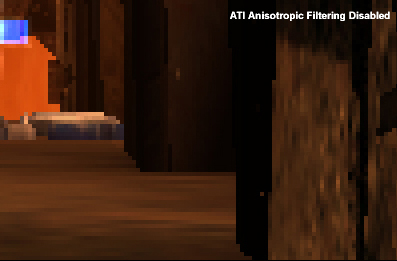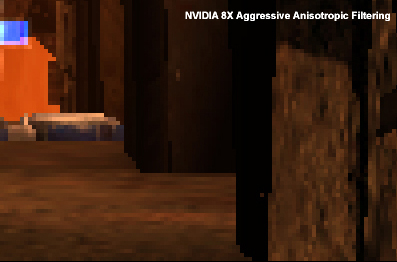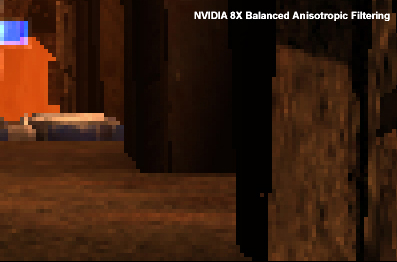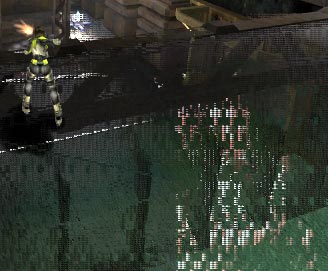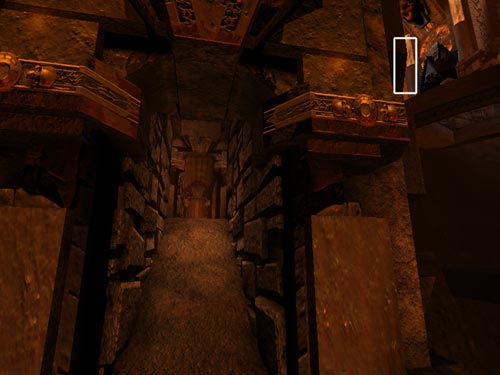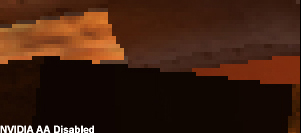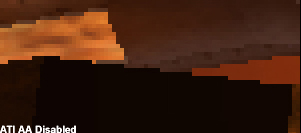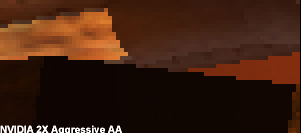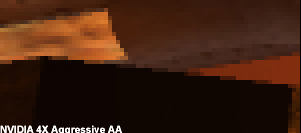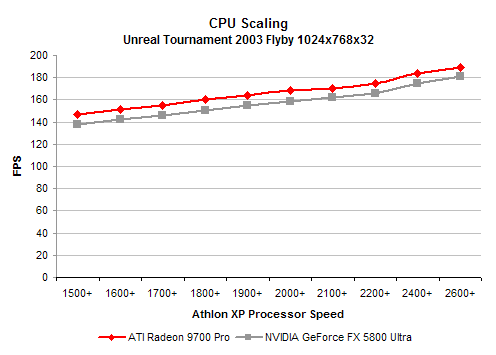|
|
|
Post your feedback @ ng_zz Forums | |||||||||||||
|
| ||||||||||||||
The CardsIn NVIDIA's usual style, there will be two flavors of the GeForce FX available in February - the GeForce FX 5800 Ultra and the regular 5800. The GeForce FX 5800 Ultra will retail for $399, just like ATI's Radeon 9700 Pro; we'd expect street prices to be a bit higher than the 9700 Pro, at least initially. As NVIDIA originally claimed, the FX 5800 Ultra will be shipping with a 500MHz core clock at 1GHz memory clock (effectively 1GHz that is). The card we received is what will be shipping in February and features the unique 2-slot cooling solution that NVIDIA shocked everyone with at Comdex.
We'll talk about cooling in a bit but just by looking at the card you can tell that the GeForce FX 5800 isn't cheap to manufacture, not by a long shot. All of the materials that go into the cooling system and mounting it on the card definitely increase manufacturing costs well beyond what ATI's board partners have to deal with, so it will be interesting to see if street prices for the GeForce FX will be able to rival those of the 9700 Pro.
The 0.13-micron NV30 GPU and its 1GHz memory are power hogs and thus the 4-pin standard HDD power connector are present on the PCB. If you fail to plug in the power connector the card will still function and it will let you into your OS without any problems. The card will underclock itself from the stock 500/1GHz settings to 250/500MHz; assuming that the GeForce FX's drivers are installed a window will pop up reminding you to plug in the power connector. The regular GeForce FX 5800 will be priced around $299 and ships with a much lower 400MHz core clock and 800MHz memory. By reducing the core and memory clocks, NVIDIA's board partners should be able to produce regular 5800 solutions in a single-slot design although none were ready at the time of this review for us to include pictures of. We did include benchmarks at 400/800 to give you an idea of where the performance of the regular 5800 will lie. |
Cooling the BeastThe most stunning part of the GeForce FX 5800 Ultra is its utterly insane cooling system and the first thought that popped into our minds when we saw it was: noise. With the GeForce FX, NVIDIA borrowed some of their mobile technology to help minimize the amount of noise their cooling system would produce.
For starters, when the 3D pipeline is not in use the card will operate at lower clock speeds (300 core / 600 mem to be specific). The lower clock speeds enables NVIDIA to run the very loud fan at a much slower speed and still provide adequate cooling to the GPU and its memory. As soon as there is activity in the 3D pipeline, the clock speeds increase to their 3D setting (500/1GHz) and the fan spins quicker to deal with the increased temperatures.
To give you an idea of how loud the GeForce FX 5800 Ultra can get we've recorded two videos several inches away from a GeForce FX 5800 Ultra and a Radeon 9700 Pro for comparison purposes. The FX 5800 Ultra video starts out in 2D mode and then we start up a game, triggering an increase in clock and fan speed which you'll definitely be able to hear. Remember that these videos were made very close to the actual source of the sound, so it's much like putting your ear up to either one of these cards. ATI
Radeon 9700 Pro in action (AVI) To further extend the comparison, the GeForce FX 5800 weighed in at 77 dBA on our sound meter with the fan spun all the way up vs. 64 dBA on the Radeon 9700 Pro. With the fan in its "slow" mode the card was still louder than the Radeon 9700 Pro but not nearly as bad. The rear heatsink on the GeForce FX 5800 also got quite warm, the maximum temperature of the surface reached 131F as it is still not being passively cooled. Remember that the fan setup on the GeForce FX only cools the GPU and the memories mounted on the front of the PCB, the back is cooled passively. An interesting phenomenon we discovered while attempting to overclock the GeForce FX was that when the card got too hot (courtesy of our overclock), it automatically throttled itself down to its 2D speed (300/600MHz) and reduced the fan speed accordingly in the middle of a game. We're not exactly big fans of this method of protection, since it would make more sense to reduce the clock speed to its 3D default setting and not the significantly slower 2D clocks. If you are curious, the card underclocked itself after running at a 540MHz core clock for a matter of minutes, and we couldn't get the memory up above 1100MHz too reliably either; as expected, there's not much headroom in the GeForce FX 5800 although that may change over the life of the chip as the manufacturing process is tuned. |
The DriversNVIDIA supplied beta drivers to us that properly recognized the GeForce FX 5800 Ultra - v42.63. Other than an issue with enabling NVIDIA's 4XS AA mode (we'll discuss that later), we had no issues with the drivers on either our AMD or Intel test systems. After extensive testing however, it's clear that NVIDIA does have a good amount of optimization to work on before the GeForce FX is truly ready to compete with the likes of the Radeon 9700 Pro; you'll understand why as we take you through the performance tests. The drivers have very similar control panels to what we're all familiar with, with a few new additions that are GeForce FX specific:
AA and Anisotropic Filtering settings are controlled in OpenGL and Direct3D by this single set of sliders:
The Performance - Balanced/Aggressive slider at the top controls the anisotropic filtering quality/performance settings. The Balanced setting offers higher image quality while the Aggressive setting offers greater performance. |
The TestSince the focus of this review is the performance of the two fastest desktop GPUs there are a few assumptions we can make, the biggest being that you don't buy a card like the GeForce FX 5800 Ultra to run without Anti-Aliasing or Anisotropic Filtering enabled. For this reason the vast majority of our benchmarks will be focused on the performance with AA/AF enabled, but we will include an abridged set of numbers without those features turned on to be as complete as possible.
| ||||||||||||||||
Quick Performance Intro (AA/AF Disabled)Before we get into the truly strenuous benchmarks let's have a look at some scores without AA & Anisotropic Filtering enabled. First things first, synthetic benchmarks using 3DMark 2001:
3DMark 2001 SE helps confirm that NVIDIA is able to deliver as expected in terms of fill rate; with a much higher core clock (500MHz vs. 325MHz) it's no surprise that the GeForce FX 5800 Ultra comes away with a 37% higher fill rate in 3DMark than the Radeon 9700 Pro. What you have to take into account however is the fact that the Radeon 9700 Pro actually has more raw memory bandwidth than the GeForce FX (when you ignore the always-on color compression of the FX), which can significantly reduce any real-world fill rate advantage NVIDIA may have. The rest of the 3DMark numbers are generally in favor of the GeForce FX but there are a few cases when the 5-month old Radeon 9700 Pro comes out on top. Let's move on to some real-world benchmarks before we conclude this quick performance intro and start focusing on why you'd really want to purchase one of these cards - for Anisotropic/AA performance.
What once used to be only true for video cards at 640x480 is now true for these power houses at 1024x768, being mostly CPU/driver limited that is. At 1024x768 we're not really stressing anything but what's very interesting and impressive on ATI's part is that the Radeon 9700 Pro is slightly faster than the GeForce FX. If you remember back to all previous ATI cards, in CPU/driver bound situations ATI was almost never on top. It always took turning on AA or cranking up the resolution in order to let ATI's bandwidth advantages (if they existed) to kick in and give them the performance advantage, but here we have ATI on top from the start. It just goes to show you how far along ATI's driver team has come and how mature the Radeon 9700 Pro is, considering that it has been shipping for close to 6 months now.
Due to popular demand we've included graphs of minimum frame rates as well as average frame rates in situations where the benchmark reports the data to us. Here we see that the GeForce FX, for whatever reason, has much lower minimum frame rates than the Radeon 9700 Pro. We have no explanation for this other than we hope it is an issue with the current GeForce FX drivers.
As we increase the resolution the GeForce FX 5800 Ultra actually begins to pull away from the Radeon 9700 Pro, here establishing a 13% performance advantage. But now let's have a look at the minimum frame rates:
Once again we see that while the average frame rates are quite high, the GeForce FX 5800 falls far behind even the regular Radeon 9700 in the lowest frame rates attained during the course of the benchmark.
At 1600x1200 even the regular GeForce FX 5800 is able to outperform the Radeon 9700 Pro in average frame rate numbers, but once the attention shifts to the minimum frame rates...
The GeForce FX doesn't do nearly as bad in comparison to the Radeon 9700 Pro here, as the minimum frame rates are relatively similar across the board at this high of a resolution. It's nice to note that all of these cards can provide minimum frame rates at around the 60 fps mark at 1600 x 1200. |
Quick Performance Intro (AA/AF Disabled) - Seroius Sam 2The only other benchmark we ran with AA/AF disabled was Serious Sam 2: The Second Encounter (Demo) using the Little Trouble benchmark. As usual we used the Extreme Quality defaults but disabled Anisotropic Filtering (we'll be saving those benchmarks for a later section).
Once again we see that the GeForce FX 5800 Ultra holds a small but reasonable (9%) performance advantage over the Radeon 9700 Pro.
The minimum frame rate numbers are a bit more reliable under Serious Sam because we can report the sustained minimum frame rates, rather than the instantaneous minimums; thus these scores are much less prone to being thrown off by minor issues that would cause significant but short drops in frame rate.
At higher resolutions the performance gap between the GeForce FX 5800 Ultra and the Radeon 9700 Pro is reduced instead of increased, in this case it is only 5%. This is a perfect case of ATI's raw memory bandwidth advantages outweighing any fill rate advantages that the GeForce FX has.
The minimum frame rates continue to be very close...
Finally at 1600x1200 we see that virtually all performance advantage has been erased, as the GeForce FX 5800 Ultra is barely 1% faster than the Radeon 9700 Pro in this case.
Now that we've gotten that out of the way, let's really stress these cards by turning on some eye-candy... |
Anisotropic Filtering QualityWith the Radeon 8500 and 9700 Pro, ATI brought anisotropic filtering to the mainstream by introducing a filtering engine that minimized the performance hit seen with anisotropic enabled. Because of the pressure ATI put on NVIDIA, the GeForce FX driver lets you choose between two different anisotropic filtering modes that adjust the engine between optimizing for performance and image quality, the two options being Balanced and Aggressive. ATI has two similar options, at least in name, in their drivers for the Radeon 9700 Pro; ATI calls the two options performance and quality.
In order to compare the various anisotropic filtering modes we chose this scene from the Inferno Flyby in Unreal Tournament 2003. The white box is the area we zoomed in on (400%) to investigate the quality of ATI's anisotropic filtering vs. NVIDIA's engine in the GeForce FX. First let's look at the highest image quality settings offered by NVIDIA, which in the case of the GeForce FX is an 8-sample algorithm. To view the different screenshots simply hold your mouse over the appropriate link and the corresponding screenshot will appear. By default, anisotropic filtering disabled is the screenshot that will be shown if you don't mouse-over one of the other links:
Here you can see there noticeable differences between NVIDIA's aggressive and balanced settings, although both are a definite improvement over no-anisotropic filtering as you would expect. Next we have ATI's AF options:
What makes ATI's solution so great is that there is virtually no discernible image quality difference when you compare the Performance and Quality settings. We included shots of ATI's 16X setting as well just to show that there is a slight increase in image quality, but for a fair comparison we will put NVIDIA's 8X up against ATI's 8X. |
Anisotropic Filtering Quality ComparedNow that you've seen what each card can do, let's compare the two head-to-head. We spent a good amount of time comparing all of ATI's AF settings to NVIDIA's on the GeForce FX, but instead of showing you the conclusion we came to let's take a look at what NVIDIA recommends in their reviewer's guide for the GeForce FX:
So the first and most obvious test is to compare NVIDIA's Performance - Aggressive mode to ATI's Performance mode; the default screenshot is NVIDIA's Aggressive and mousing-over the image will swap to ATI's Performance mode.
As you can see, ATI's Performance mode offers significantly better image quality than NVIDIA's Aggressive; the comparison is not as close as NVIDIA would like to suggest. So if NVIDIA's Aggressive mode doesn't look as good as ATI's Performance mode, what about NVIDIA's Balanced mode? That's the next thing we tested; this time around NVIDIA's Balanced mode is the default screenshot, but holding your mouse over the image will give you ATI's Performance mode once again:
Here we have a much better comparison, ATI's Performance mode is virtually identical to NVIDIA's Balanced mode. To finish off the comparison we have NVIDIA's Balanced mode vs. ATI's Quality mode:
Since there is virtually no difference between ATI's Performance and Quality modes, we see that NVIDIA's Balanced mode is comparable to ATI's Quality mode as well as their Performance mode. In the end, we see that it is a fair to compare NVIDIA's Balanced mode to either of ATI's AF modes, however you cannot compare NVIDIA's Aggressive mode to either of ATI's options as NVIDIA's image quality is significantly worse. |
Anisotropic Filtering PerformanceNow that we've concluded that NVIDIA's 8X Balanced AF mode is comparable to either of ATI's 8X modes, let's figure out how all of the options perform:
NVIDIA's Performance - Aggressive AF setting results in virtually no performance hit, which isn't anything to complain about however once you take into account the fact that it doesn't compare visually to ATI's Performance setting it is not as impressive. NVIDIA's Performance - Balanced setting incurs a much larger performance hit, but it is the only option that is visually comparable to ATI's AF. Let's see how the decreased clock speed and lesser memory bandwidth of the regular GeForce FX 5800 changes the picture:
With less memory bandwidth to spare, the regular FX 5800 does take a noticeably larger performance hit when AF is enabled. Finally we have the Radeon 9700 Pro:
ATI's Performance AF setting incur a much larger performance drop than NVIDIA's Performance - Aggressive mode, but that's understandable considering that ATI's setting offers noticeably improved image quality. On the flip side of things, ATI's Quality setting takes a larger performance hit than NVIDIA's Performance - Balanced mode. So what do we compare? Based on our image quality assessments from the previous page, it is clear that we can't compare NVIDIA's Performance - Aggressive mode to either of ATI's AF modes. And although there is only a 1% performance drop between ATI's 8X and 16X modes, in order to compare apples-to-apples we stick to 8X AF modes with both cards. The choice comes down to whether we use ATI's Performance or Quality modes for the Radeon 9700 Pro, since there's virtually no perceivable difference in image quality we focus the majority of our benchmarks on NVIDIA's 8X Performance - Balanced AF vs. ATI's 8X Performance AF. |
Anti-Aliasing QualityNow that we've investigated the GeForce FX's Anisotropic Filtering modes, the next step is to see how well its Anti-Aliasing engine works. We followed the same procedure as we did with our AF investigation, and in doing so we managed to uncover a bug in the 42.63 drivers NVIDIA sent us for testing; it turns out that a bug in this build of the drivers causes visual artifacts if NVIDIA's 4XS Anti-Aliasing is enabled, and thus we had to exclude that setting from our tests.
NVIDIA plans to fix this bug in a later revision of the driver, but given that it was the weekend they could not fix it in time for this review. Below you'll find the scene we used from the same Inferno Flyby in Unreal Tournament 2003 for our AA quality tests: |
Anti-Aliasing Quality ComparedThis comparison works the same way our ATI vs. NVIDIA AF comparisons worked, by default NVIDIA's 2X is showing in the image below but all you have to do is hold your mouse over the image and you'll see ATI's 2X AA:
With this comparison you can get a good idea of exactly how little NVIDIA's 2X AA is doing. Looking at the ATI screenshot you can see that there are now intermediate steps between the jaggies, whereas that's completely absent from NVIDIA's 2X screenshot. So what about NVIDIA's 4X mode? We've already established that it's doing considerably more than their 2X mode, but how does it compare to ATI's 4X AA? You know the drill:
This is a much closer competition now, but you can still see a slight advantage in ATI's 4X mode. The AA samples in the ATI screenshot seem to be blended together better than what we see in the screenshot produced by the GeForce FX; it's not a huge deal, and no where near as dramatic as the 2X comparison, but it's still worth noting. So what do we compare? Since we've established that NVIDIA's 2X setting needs some work, it looks like we'll be pitting ATI's 4X up against NVIDIA's 4X |
Anti-Aliasing Performance
With the image quality investigation over with, now it's time to look at the performance of all of these AA settings. As usual, the newcomer goes first - let's see how the GeForce FX's performance is impacted by its plethora of AA settings:
|
Just as NVIDIA has promised, both 2X and Quincunx modes are virtually "free" but as we all know, just because something is "free" doesn't mean it's good. Flip back a page to our comparison screenshots and you'll see that neither of these modes does much in the way of actually anti-aliasing, so we turn to some of the higher sampling methods.
Next up we have NVIDIA's 4X mode, which delivers around 3/4 the performance of the FX 5800 Ultra without any sort of AA enabled. As you can see, once you get beyond 4-samples you're reducing the performance of the card to less than 40% of its original capabilities.
Once again we look at the lower clocked GeForce FX 5800 to see how having less memory bandwidth and a lower fill rate influences performance:
|
The performance drops are much more pronounced on the regular 5800 as you can expect given the 20% reduction in core and memory clocks.
|
With the Radeon 9700 Pro we see that both the 2X and 4X modes take a slightly larger performance hit than the comparable settings on the GeForce FX, but what's truly interesting is ATI's 6X mode. A feature that ATI hasn't done a great job of publicizing is their frame buffer compression algorithm that is enabled only in AA modes, but it does boast a higher compression ratio than NVIDIA's 4:1 color compression algorithm. The benefit of this higher ratio compression algorithm can be seen in the relative performance of ATI's 6X AA setting, it delivers 60% of the 9700 Pro's original performance compared to the GeForce FX's 6XS mode with its 39%.
If you want numbers to quantify this difference, with 4X AA enabled the GeForce FX 5800 Ultra is around 9% faster at 1024x768 than the Radeon 9700 Pro (156.9 vs. 143.8), but switching on 6X AA puts the 9700 on top of the FX by no less than 53% (123 vs 80).
AA+AF Performance
To test these cards the way they were meant to be used we used the settings we discovered would be the best for each solution. For the GeForce FX we ran with the following settings enabled:
- 8X Performance - Balanced Anisotropic Filtering
- 4X Anti-Aliasing
The Radeon 9700 Pro was run with the following enabled:
- 8X Performance Anisotropic Filtering
- 4X Anti-Aliasing
For comparison purposes we also threw in a Radeon 9700 Pro with 8X Quality Anisotropic Filtering enabled for image quality purists, but we think that the performance setting is the best option for Radeon 9700 Pro owners and prefer its tremendous performance advantage over the slight reduction in image quality. The comparison you'll want to make is between the GeForce FX 5800 Ultra (4X AA/8X Bal Aniso) and the Radeon 9700 Pro (4X AA/8X Perf Aniso).
As usual, we'll start with performance under Unreal Tournament 2003:
|
Thanks to ATI's higher performing anisotropic filtering settings, the Radeon 9700 Pro is able to outperform the GeForce FX 5800 Ultra by a massive 20% in this test.
|
The minimum frame rates remain in line with what we saw in the average frame rate numbers; the gap between the GeForce FX and the Radeon 9700 Pro isn't nearly as large as what we saw in the AA/Aniso disabled tests because of the fact that enabling these two features increases the stress level so tremendously on these cards and thus brings down the minimum frame rates across the board.
|
As the resolution increases the performance delta between the Radeon 9700 Pro (4X AA/8X Perf Aniso) and the GeForce FX 5800 Ultra remains around 20%. Once again we see that this delta can be attributed primarily to NVIDIA's 8X Balanced Anisotropic filtering setting, had their Aggressive setting offered a higher level of image quality the FX would have definitely been on top of the competition but you can't argue with the visual evidence we provided earlier.
|
Even with 4X AA and 8X Anisotropic Filtering enabled, the Radeon 9700 Pro can still manage to pull a minimum of 52.5 fps in this test at 1280x960, which isn't bad at all. It's interesting to see that it has taken this long (remember the introduction of FSAA with the Voodoo4/5 almost 4 years ago?) for features like anti-aliasing and anisotropic filtering to be things you can turn on in virtually any situation because of the power of these GPUs.
|
At 1600x1200 the performance delta grows considerably; even if we were to compare to the Radeon 9700 Pro with 4X AA and 8X Quality Anisotropic Filtering enabled, the GeForce FX 5800 Ultra is still not able to come out on top.
|
As we start looking at other games for performance data we see that things don't change under Serious Sam 2, the standings are virtually identical to those under UT2003 with the exception of the regular FX 5800 falling to the last position. The top performing Radeon 9700 Pro ends up providing a 20% performance advantage over the GeForce FX 5800 Ultra, which is exactly the lead we saw in UT.
|
The GeForce FX 5800 Ultra gets a lot closer in this minimum frame rate chart, but is still a let down considering that it is still around 10% away from the performance of a card that has been shipping for almost 6 months now.
|
The standings remain the same as we crank up the resolution, with the top performing Radeon 9700 Pro configuration extending its lead to 24%.
|
When it comes to the minimum frame rates, the Radeon 9700 Pro holds on to its performance advantage with even the regular Radeon 9700 giving the GeForce FX a hard time.
|
At 1600x1200 it is very difficult to beat ATI's mature driver set and 256-bit memory bus, every extra bit of memory bandwidth counts and it doesn't seem as if NVIDIA's always-on color compression is doing them much of a service in outperforming ATI here.
|
AA+AF Performance - Q3A, Jedi Knight 2 & Comanche 4
For this next set of benchmarks we took three games that weren't GPU bound to begin with, and cranked up the resolution and AA/AF settings until we could see some differences between the ATI and NVIDIA offerings. We'll start out with a classic benchmark, Quake III Arena:
|
If we weren't running at 1600x1200 with 4X AA and 8X Aniso enabled we'd be seeing frame rates well above 300fps, which is pretty ridiculous. Even in this benchmark we see that the Radeon 9700 Pro outperforms the GeForce FX 5800 Ultra by 11% at most.
|
Jedi Knight 2 is another Quake III Arena engine based game and it happens to be mostly CPU bound, but after turning up the resolution and enabling AA/Aniso we were able to put together a good benchmark with some great image quality. The performance is very similar to what we saw under Quake III Arena, the GeForce FX 5800 Ultra still has some maturing to do before it can outperform the Radeon 9700 Pro. Let's hope, for NVIDIA's sake, that all it needs are some better drivers.
|
Finally, we end our real-world gaming tests with Comanche 4 - a very CPU bound flight simulator. The performance delta between the Radeon 9700 Pro and the GeForce FX is virtually nonexistent here, one of the very few cases we've seen.
AA+AF Performance - Codecreatures CodeBench
Codecult's Codecreatures engine has been turned into a fairly interesting DirectX 8.1 benchmark. Without widespread use of the engine this test ends up being no better than a synthetic benchmark, but it's interesting to see the results to help get an idea for how these cards perform under intense DirectX 8.1 applications.
|
What's interesting here is that the Codecreatures benchmark is the first situation where the GeForce FX 5800 Ultra actually exhibits a clear performance lead, in this case a 26% performance advantage over the Radeon 9700 Pro. Could this be a hint of the GeForce FX's potential? Unfortunately it's entirely too early to say for sure, it could just be that this benchmark is stressing the higher performing pixel shader engines of the GeForce FX.
|
Nothing new at 1280x1024, the GeForce FX 5800 Ultra hangs on to a 25% performance advantage.
|
And we close things out with a 40% advantage at 1600x1200. It is too bad that this is only a synthetic test and we haven't been able to see even remotely similar results in any of our real-world benchmarks.
CPU ScalingWe benchmarked the GeForce FX 5800 Ultra and the ATI Radeon 9700 Pro on every single 266MHz FSB Athlon XP to produce an interesting CPU scaling chart. The tests were conducted at 1024x768 with no anti-aliasing or anisotropic filtering enabled in order to increase the dependency on the CPU and driver subsystems. The results were interesting to say the least: |
Final WordsSo there you have it, NVIDIA's response to ATI's Radeon 9700 Pro - but does anyone else feel unfulfilled by the GeForce FX? A card that is several months late, that is able to outperform the Radeon 9700 Pro by 10% at best but in most cases manages to fall behind by a factor much greater than that. Granted the problems that plagued the launch of the FX weren't all up to NVIDIA's control, after all the decision to go 0.13-micron was made 1 - 2 years ago based on data that was available at the time. ATI took a gamble on producing a 0.15-micron part and NVIDIA did the same on their 0.13-micron NV30, and it looks like ATI guessed right. While we were reviewing the FX, looking at its performance and investigating its image quality, we found ourselves reminiscing of ATI's launch of the Radeon 8500. A card that was long overdue, but in the end unable to outshine the top performer at the time. Although the current state of the GeForce FX is much better than what we had with the first Radeon 8500, the word impressive isn't what we'd use to describe it. The performance is an improvement over the Ti 4600, without a doubt, but it does not place NVIDIA back in a position of dominance, which is what everyone was expecting from NV30. This isn't the end of NVIDIA, the company is quite healthy and they've got a number of products in the pipeline with great potential (GeForce FX included) but it does mean that the road to regaining dominance in the market will be an even more difficult one to traverse. ATI has not been sitting idle all this time, and progress on the R350 core has been coming along quite well. We proved early on that the 0.15-micron R300 core could reach speeds of up to 400MHz, and with the GeForce FX NVIDIA has established that shipping cards with 800MHz - 1GHz memory is feasible, if ATI can put together a R350 with specs close to what we're implying then even a driver-tweaked FX will not stand a chance. NVIDIA has told us that the GeForce FX will be in stores next month, and we'd expect R350 in about a month following that. It will be a close race, but what ATI has going for them right now is a much more mature driver set than NVIDIA for their flagship GPU. The 3+ month advantage ATI had in bringing the R300 into production and to market gave ATI a much bigger advantage than just being the king of the hill for a while, it gave them quite a bit of time to fine-tune and optimize their drivers for this very occasion; this is a luxury that ATI has not had previously but they have made excellent use of it today. NVIDIA's focus at this point is NV31 and NV34, after all, that's where the money is. The small percentage of the market that will go after the NV30 will not make or break NVIDIA, but should ATI compete like this in other market segments then there will be cause for worry. As we mentioned at the start of our GeForce FX Preview - "Kudos to ATI." |

